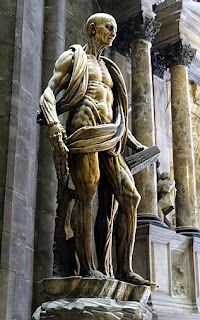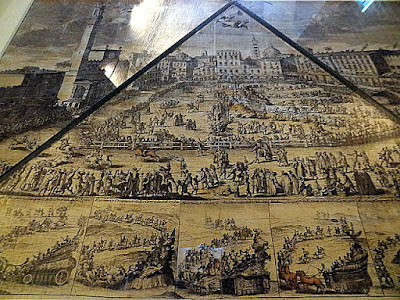We arrived in Genoa to the sobering sight of the cruise ship
Costa Concordia in a purpose-built
slip in the process of being broken up.
Some weeks earlier, we sailed past the rocks she went onto in Giglio,
the result of one man’s arrogant idiocy and chest-beating attempts to impress
his current paramour. He has been tried and found guilty and
sentenced to 16 years in prison for the crime he committed, which killed 32
people. He remains free until his
appeals are exhausted. S.O.B.
Around the corner from there was a massive cruise liner, and
just as we came into the lagoon, she began to move out. Not a lot of room there so Terry steered off
to a holding basin and let her go out then moved on in to Porto Turistico de
Genoa.
 |
| Costa Concordia wreck |
And a fine marina this is, too. In the best of traditions, you step off the
boat and you are in town, on the maritime boardwalk with its tourist
attractions, African hustlers trying to “sell” you the information that the
Aquarium, which you can see, is where you can see it, a huge pirate ship
replica and endless bars, cafes and boutiques. It seems that many waterfront
planners believe that people on boats do nothing but eat out, drink and shop!
It is usually much easier to find a pair of fancy sandals than a laundry,
supermarket or chandler. However, it was just a short walk into town to find
everything we needed, including the great cafes, bars, restaurants, specialty
shops and markets that no respectable Italian city would be without. There is
an excellent maritime museum that takes you on a journey through the whole
history of Mediterranean navigation, including maps and instruments from the
great age of European exploration and conquest.
 |
| Columbus and Vespucci |
Genoa is full of signs of its past wealth. There are
extraordinary buildings and streetscapes, mostly from the heady days of empire
between the fifteenth and seventeenth centuries. Amongst many other historic
ventures, the great voyages of Christopher Columbus and Amerigo Vespucci set
off from here, and there are monuments and artefacts dedicated to both. Also a
prominent part of the cityscape are the grand palazzos of the wealthy
merchants, many of which are now museums. A stroll down Via Garibaldi, a street
along the high ground overlooking the harbour, is a must. The palazzos here
house fabulous furniture and artworks, including many works by Flemish
painters, collected during the 17th century when Genoa had a very
active trade with Flanders.
 |
Magnificent inlaid furniture
 |
 |
| A very rude Flemish painting - see if you can see why? |
Besides its excellent maritime museum and its palazzos, one
of the highlights of the city is its cathedral, San Lorenzo. Like several other
churches, the cathedral claims to house the Holy Grail. This one is a rather
unlikely green glass dish, sitting alongside various bones, nails and splinters
of wood (from the True Cross) in their precious gold and silver reliquaries.
 |
| All gold and silver. $$$$$$$$ |

As we were walking around the train station one afternoon,
we happened to see that Milan was on the boards. So next morning, early, it was off first
class for a look at Italy’s capital of fashion and design.
 |
| 1st Class in Trenitalia |
And there it all was
– the famous names in jewellery, shoes, clothing, homewares – exclusive
boutiques with a single rack of clothes and the most intimidating salespersons
I’ve ever seen (don’t put your foot through the door unless it’s wearing Manolo
Blahniks...). Luxury cars and beautiful people are everywhere.
 |
| This is how you do a classy shopping mall |
Sadly, there is a six-month waiting list to view Milan’s
greatest treasure, Leonardo’s Last Supper, but we did find a good alternative:
 |
| Of the many Last Suppers we've seen, this one had the best supper.... |
The cathedral in Milan provides quite a contrast to
Genova’s. The outside is an incredibly ornate confection in white marble, with
every possible surface carved in saints, angels, demons and imaginary creatures
of all kinds. The inside must have been the inspiration for the Dwarf kingdom
of Moria in Peter Jackson’s
Lord of the
Rings films, with its massive grey columns and soaring Gothic arches. A
trip to the roof is essential for amazing views of the saints close up, and the
panorama of the city all around.
 |
| The roof of the Cathedral |
 |
| St Bartholemew, martyred by being flayed alive |
 |
| The Mines of Moria? |
Unfortunately we were not so impressed with Italian rail on
the return journey. We couldn’t locate
the platform for our 18:10 departing train and were rushing up and down looking
for it. None of the uniformed personnel had any idea why it wasn’t on the
boards until finally we found one who said “cancelled” and directed us to a
regional train on the far end platform.
It was a real struggle to get to it as it was ready to leave, and Carol
had a hard time making the distance. We settled in to a not-first-class pair of
seats, with no access to refreshments, sorely needed after our busy day and not
available in second-class. As a regional
train, first was not an option. After many more stops than the express to Genoa
would have made, we finally arrived and got water and food. Terry’s attempts to
get a refund resulted in unhelpful “help” and a maddening website loop. It was
a great day out nevertheless.
 |
| Milan's most famous gourmet store |
So, back to Genoa for re-stocking and preparing to leave
Italy at last. Our plan was to pay brief visits to friends in Toulon, Barcelona
and St Carles, arriving at our winter port of Cartagena by the end of September.
From there, we planned to travel back to Italy for a catch up with Australian
friends in Positano. As all cruisers know, plans are one thing; the reality of
weather, sea and boats can often be quite another…






























































